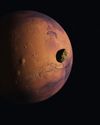
TIME ON THE ISS
The ISS completes an orbit in 90 minutes, so how do astronauts keep track of time? The ISS uses Coordinated Universal Time (UTC). It was selected as the time zone for the ISS because it’s around the mid-point for all ISS partners.
The International Space Station (ISS) is a multinational laboratory orbiting 400 kilometres (248 miles) above our heads. It perhaps comes as no surprise that the ISS can easily be seen from Earth. The colossal structure reflects sunlight and appears as a bright, white pinpoint of light in the sky – typically the brightest object in the sky except for the Moon – and can even be spotted from the middle of a city. The ISS is therefore a great skywatching and astrophotography target for those living in urban and rural areas alike. Spotting the ISS requires no specialist equipment as it can be seen with the naked eye. All you need to know is where to look and when.
“The International Space Station’s trajectory passes over more than 90 per cent of Earth’s population,” says NASA. The ISS zips around the Earth at an average speed of 28,000 kilometres (17,500 miles) per hour, completing 16 orbits per day. As the ISS orbits with an inclination of 51.6 degrees, if you live beyond 51.6 degrees north or south of the equator the ISS will never appear directly overhead. The ISS is only visible because it reflects sunlight. It isn’t bright enough to be seen in the middle of the day, and the best time to view the ISS is either at dawn or dusk. Viewing opportunities of the ISS can vary between one sighting a month to several a week, depending on your location and the orbit of the ISS.
هذه القصة مأخوذة من طبعة Issue 127 من All About Space.
ابدأ النسخة التجريبية المجانية من Magzter GOLD لمدة 7 أيام للوصول إلى آلاف القصص المتميزة المنسقة وأكثر من 9,000 مجلة وصحيفة.
بالفعل مشترك ? تسجيل الدخول
هذه القصة مأخوذة من طبعة Issue 127 من All About Space.
ابدأ النسخة التجريبية المجانية من Magzter GOLD لمدة 7 أيام للوصول إلى آلاف القصص المتميزة المنسقة وأكثر من 9,000 مجلة وصحيفة.
بالفعل مشترك? تسجيل الدخول

MYSTERIES OF THE UNI WHERE ARE ALL THE SPIRAL GALAXIES?
There are far fewer spiral galaxies than elliptical ones in the Supergalactic Plane, and scientists are keen to discover why

ZOMBIE STARS
+10 OTHER TERRIFYING SPACE OBJECTS

HOW TO BEAT LIGHT POLLUTION
Thought it was impossible to observe the wonders of the night sky from towns and cities? Think again. Follow our tips and tricks on successfully observing through sky glow

15 STUNNING STAR CLUSTERS
These beautiful stellar groupings are spattered across the cosmos

Eileen Collins "It was a difficult mission...we were the first to see Mir"
Having served as both the first female pilot and first female commander of NASA's Space Shuttle, Collins boosted the involvement of women in space exploration to a whole new level

MARS LEAKS FASTER WHEN IT'S CLOSER TO THE SUN
The Red Planet has lost enough water to space to form a global ocean hundreds of kilometres deep

FUTURE TECH KANKOH-MARU
This ambitious reusable spacecraft will be capable of taking 50 people to and from orbit

THE FINAL FRONTIER
Beyond the reach of the Sun is a fascinating region of the cosmos that were only just beginning to explore

A long-lost moon could explain Mars' weird shape and extreme terrain
A long-lost moon could explain why Mars is so different from the other rocky planets in the Solar System. Today Mars has two tiny moons.

A sprinkling of cosmic dust may have helped kick-start life on Earth
Cosmic dust may have helped kick-start life on Earth. New findings challenge a widely held assumption that this wasn't a plausible explanation.